Abstract
Pemphigus vulgaris (PV) is a rare, potentially fatal, autoimmune disease that affects the skin and mucous membranes. The PV antigen (PVA) has been characterized as desmoglein 3. PV patients carry HLA-DR4- or HLA-DR6-bearing extended haplotypes. We recently demonstrated that patients with active disease have high titers of PV autoantibodies of the IgG1 and IgG4 subclasses. Patients in remission, healthy unaffected relatives, and some MHC-matched normal individuals have low levels of PV autoantibodies, which are IgG1 only. Furthermore, intraperitoneal injection of IgG from patients with active disease caused clinical disease in mice, but IgG from patients in remission, healthy relatives, or MHC-matched normal individuals did not. We prepared 12 peptides of 30 amino acids each (peptides Bos 1-12) spanning the extracellular domain of PVA. Patients with active disease recognize peptides Bos 1 and Bos 6 with high titers of IgG1 and IgG4 autoantibodies. Patients in remission have IgG1 autoantibodies to peptide Bos 1 only, in statistically significantly lower titers (P < 0.01). They no longer have IgG4 subclass autoantibodies to peptide Bos 6. Healthy relatives and normal unrelated individuals have low levels of only IgG1 autoantibodies that recognize only Bos 1. In vitro studies indicate that Bos 6-specific IgG and, to a lesser extent, Bos 1-specific IgG can cause acantholysis. Our data suggest that Bos 6-specific IgG4 is probably the main acantholytic autoantibody, while Bos 1-specific IgG4 may act as a facilitator or enhancer of the process. In this study we illustrate some of the paradigms that demonstrate the interactions between the MHC, subclass of autoantibodies, and peptide specificities of the autoantibodies in the autoimmune process. Thus, PV provides an important model to study the pathogenesis of autoimmunity.
Full text
PDF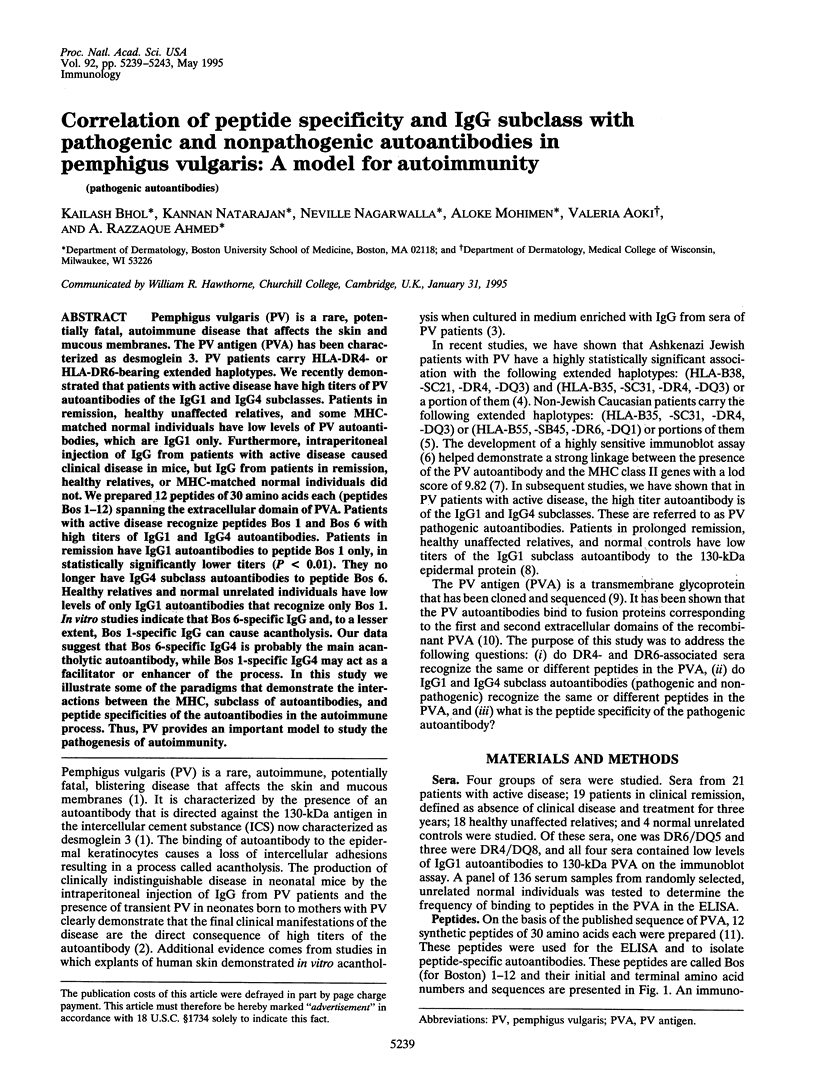
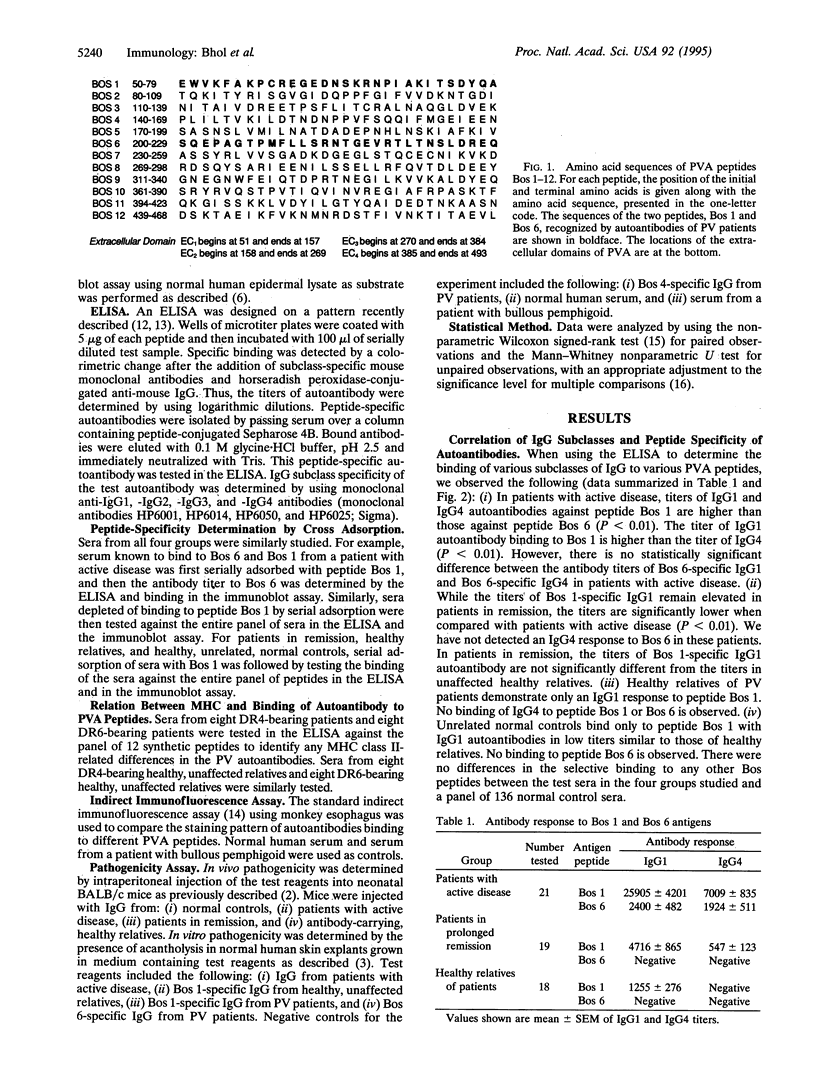
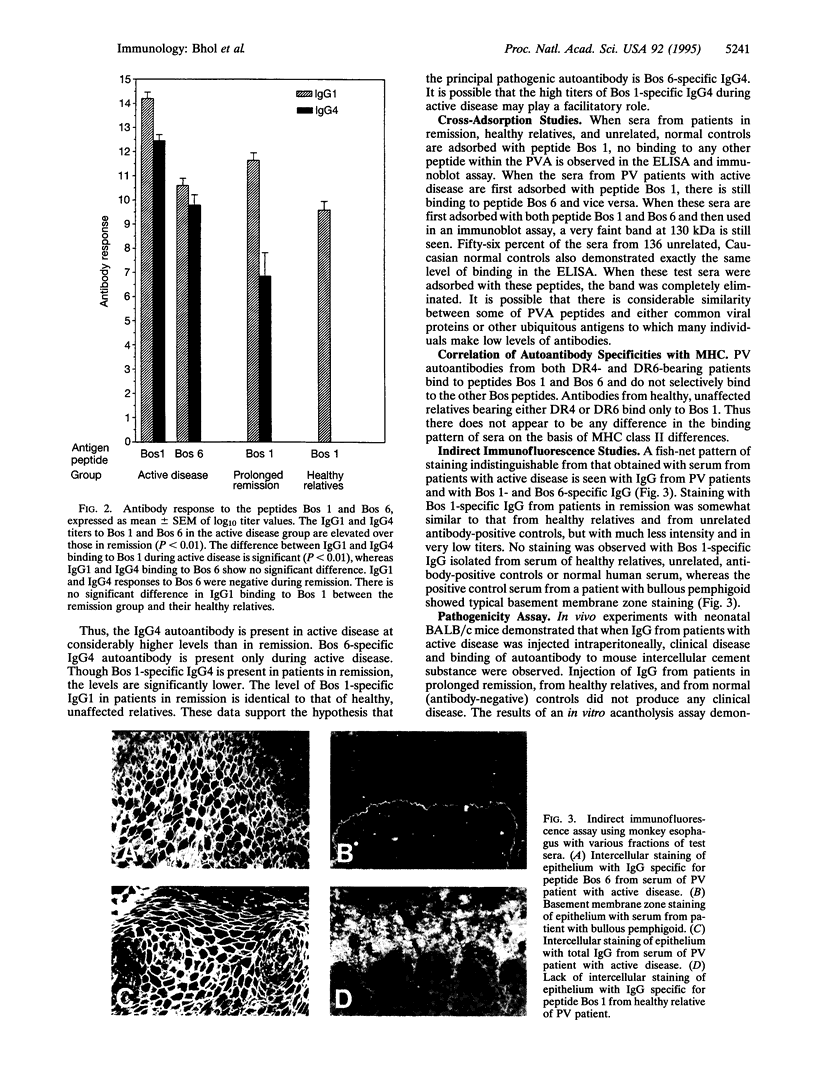
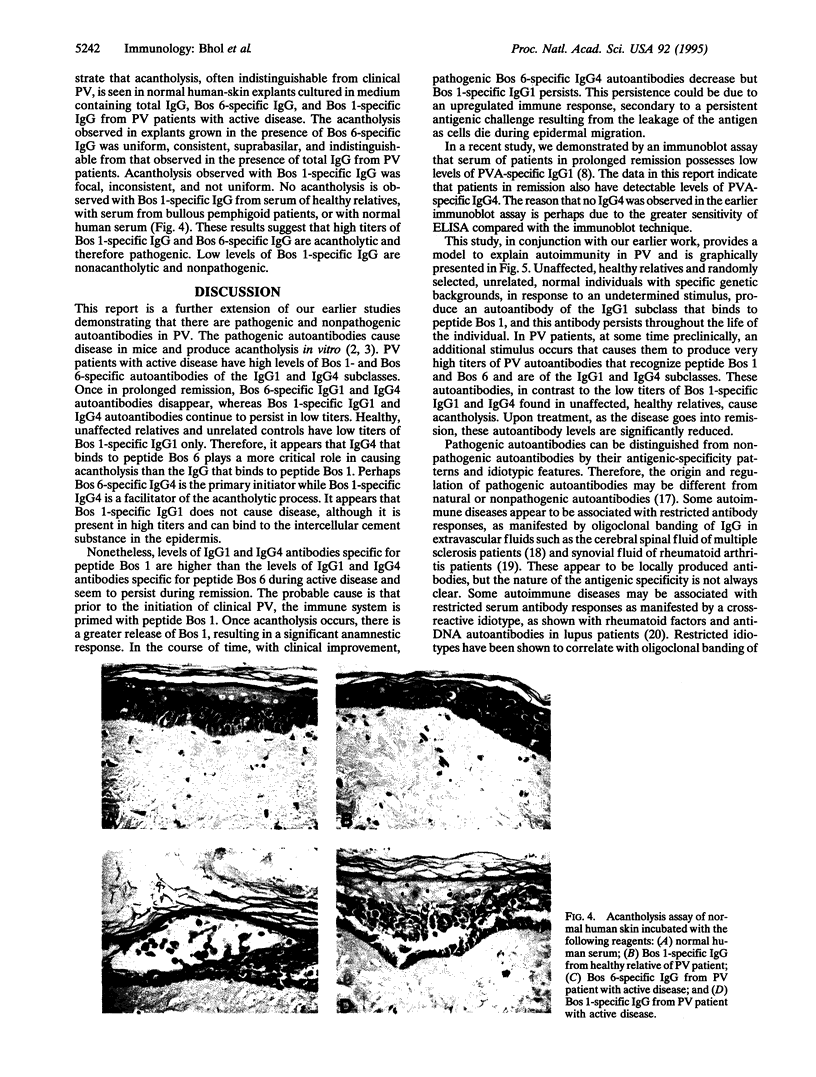
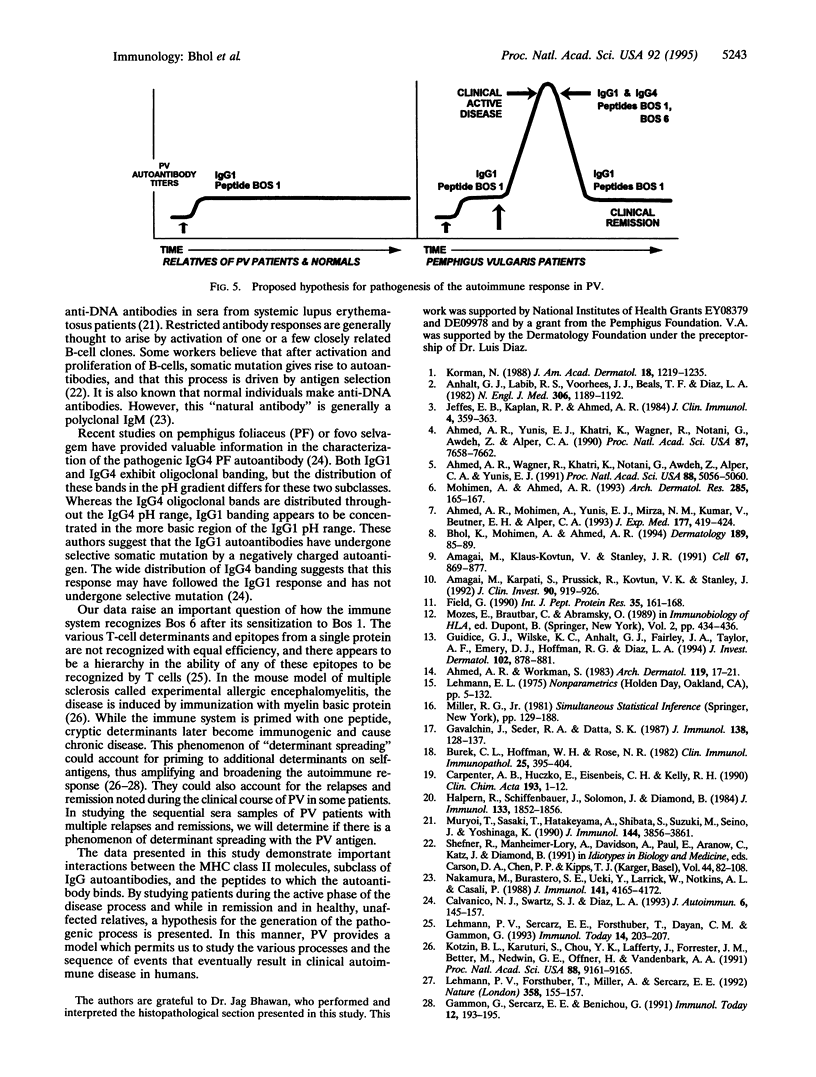
Images in this article
Selected References
These references are in PubMed. This may not be the complete list of references from this article.
- Ahmed A. R., Mohimen A., Yunis E. J., Mirza N. M., Kumar V., Beutner E. H., Alper C. A. Linkage of pemphigus vulgaris antibody to the major histocompatibility complex in healthy relatives of patients. J Exp Med. 1993 Feb 1;177(2):419–424. doi: 10.1084/jem.177.2.419. [DOI] [PMC free article] [PubMed] [Google Scholar]
- Ahmed A. R., Wagner R., Khatri K., Notani G., Awdeh Z., Alper C. A., Yunis E. J. Major histocompatibility complex haplotypes and class II genes in non-Jewish patients with pemphigus vulgaris. Proc Natl Acad Sci U S A. 1991 Jun 1;88(11):5056–5060. doi: 10.1073/pnas.88.11.5056. [DOI] [PMC free article] [PubMed] [Google Scholar]
- Ahmed A. R., Workman S. Anti-intercellular substance antibodies. Presence in serum samples of 14 patients without pemphigus. Arch Dermatol. 1983 Jan;119(1):17–21. doi: 10.1001/archderm.119.1.17. [DOI] [PubMed] [Google Scholar]
- Ahmed A. R., Yunis E. J., Khatri K., Wagner R., Notani G., Awdeh Z., Alper C. A. Major histocompatibility complex haplotype studies in Ashkenazi Jewish patients with pemphigus vulgaris. Proc Natl Acad Sci U S A. 1990 Oct;87(19):7658–7662. doi: 10.1073/pnas.87.19.7658. [DOI] [PMC free article] [PubMed] [Google Scholar]
- Amagai M., Karpati S., Prussick R., Klaus-Kovtun V., Stanley J. R. Autoantibodies against the amino-terminal cadherin-like binding domain of pemphigus vulgaris antigen are pathogenic. J Clin Invest. 1992 Sep;90(3):919–926. doi: 10.1172/JCI115968. [DOI] [PMC free article] [PubMed] [Google Scholar]
- Amagai M., Klaus-Kovtun V., Stanley J. R. Autoantibodies against a novel epithelial cadherin in pemphigus vulgaris, a disease of cell adhesion. Cell. 1991 Nov 29;67(5):869–877. doi: 10.1016/0092-8674(91)90360-b. [DOI] [PubMed] [Google Scholar]
- Anhalt G. J., Labib R. S., Voorhees J. J., Beals T. F., Diaz L. A. Induction of pemphigus in neonatal mice by passive transfer of IgG from patients with the disease. N Engl J Med. 1982 May 20;306(20):1189–1196. doi: 10.1056/NEJM198205203062001. [DOI] [PubMed] [Google Scholar]
- Bhol K., Mohimen A., Ahmed A. R. Correlation of subclasses of IgG with disease activity in pemphigus vulgaris. Dermatology. 1994;189 (Suppl 1):85–89. doi: 10.1159/000246938. [DOI] [PubMed] [Google Scholar]
- Burek C. L., Hoffman W. H., Rose N. R. The presence of thyroid autoantibodies in children and adolescents with autoimmune thyroid disease and in their siblings and parents. Clin Immunol Immunopathol. 1982 Dec;25(3):395–404. doi: 10.1016/0090-1229(82)90204-5. [DOI] [PubMed] [Google Scholar]
- Calvanico N. J., Swartz S. J., Diaz L. A. Affinity immunoblotting studies on the restriction of autoantibodies from endemic pemphigus foliaceus patients. J Autoimmun. 1993 Apr;6(2):145–157. doi: 10.1006/jaut.1993.1012. [DOI] [PubMed] [Google Scholar]
- Carpenter A. B., Huczko E., Eisenbeis C. H., Jr, Kelly R. H. Evidence for locally synthesized and clonally restricted immunoglobulin in the synovial fluid from rheumatoid arthritis patients. Clin Chim Acta. 1990 Dec 13;193(1-2):1–12. doi: 10.1016/0009-8981(90)90002-a. [DOI] [PubMed] [Google Scholar]
- Gammon G., Sercarz E. E., Benichou G. The dominant self and the cryptic self: shaping the autoreactive T-cell repertoire. Immunol Today. 1991 Jun;12(6):193–195. doi: 10.1016/0167-5699(91)90052-U. [DOI] [PubMed] [Google Scholar]
- Gavalchin J., Seder R. A., Datta S. K. The NZB X SWR model of lupus nephritis. I. Cross-reactive idiotypes of monoclonal anti-DNA antibodies in relation to antigenic specificity, charge, and allotype. Identification of interconnected idiotype families inherited from the normal SWR and the autoimmune NZB parents. J Immunol. 1987 Jan 1;138(1):128–137. [PubMed] [Google Scholar]
- Giudice G. J., Wilske K. C., Anhalt G. J., Fairley J. A., Taylor A. F., Emery D. J., Hoffman R. G., Diaz L. A. Development of an ELISA to detect anti-BP180 autoantibodies in bullous pemphigoid and herpes gestationis. J Invest Dermatol. 1994 Jun;102(6):878–881. doi: 10.1111/1523-1747.ep12382738. [DOI] [PubMed] [Google Scholar]
- Halpern R., Schiffenbauer J., Solomon G., Diamond B. Detection of masked anti-DNA antibodies in lupus sera by a monoclonal anti-idiotype. J Immunol. 1984 Oct;133(4):1852–1856. [PubMed] [Google Scholar]
- Jeffes E. W., 3rd, Kaplan R. P., Ahmed A. R. Acantholysis produced in vitro with pemphigus serum: hydrocortisone inhibits acantholysis, while dapsone and 6-mercaptopurine do not inhibit acantholysis. J Clin Immunol. 1984 Sep;4(5):359–363. doi: 10.1007/BF00917138. [DOI] [PubMed] [Google Scholar]
- Korman N. Pemphigus. J Am Acad Dermatol. 1988 Jun;18(6):1219–1238. doi: 10.1016/s0190-9622(88)70128-0. [DOI] [PubMed] [Google Scholar]
- Kotzin B. L., Karuturi S., Chou Y. K., Lafferty J., Forrester J. M., Better M., Nedwin G. E., Offner H., Vandenbark A. A. Preferential T-cell receptor beta-chain variable gene use in myelin basic protein-reactive T-cell clones from patients with multiple sclerosis. Proc Natl Acad Sci U S A. 1991 Oct 15;88(20):9161–9165. doi: 10.1073/pnas.88.20.9161. [DOI] [PMC free article] [PubMed] [Google Scholar]
- Lehmann P. V., Forsthuber T., Miller A., Sercarz E. E. Spreading of T-cell autoimmunity to cryptic determinants of an autoantigen. Nature. 1992 Jul 9;358(6382):155–157. doi: 10.1038/358155a0. [DOI] [PubMed] [Google Scholar]
- Lehmann P. V., Sercarz E. E., Forsthuber T., Dayan C. M., Gammon G. Determinant spreading and the dynamics of the autoimmune T-cell repertoire. Immunol Today. 1993 May;14(5):203–208. doi: 10.1016/0167-5699(93)90163-F. [DOI] [PubMed] [Google Scholar]
- Mohimen A., Ahmed A. R. Immunoblot assay to study the pemphigus vulgaris antigen in normal human epidermis and COLO-16 cell line. Arch Dermatol Res. 1993;285(3):165–167. doi: 10.1007/BF01112920. [DOI] [PubMed] [Google Scholar]
- Muryoi T., Sasaki T., Hatakeyama A., Shibata S., Suzuki M., Seino J., Yoshinaga K. Clonotypes of anti-DNA antibodies expressing specific idiotypes in immune complexes of patients with active lupus nephritis. J Immunol. 1990 May 15;144(10):3856–3861. [PubMed] [Google Scholar]
- Nakamura M., Burastero S. E., Ueki Y., Larrick J. W., Notkins A. L., Casali P. Probing the normal and autoimmune B cell repertoire with Epstein-Barr virus. Frequency of B cells producing monoreactive high affinity autoantibodies in patients with Hashimoto's disease and systemic lupus erythematosus. J Immunol. 1988 Dec 15;141(12):4165–4172. [PubMed] [Google Scholar]
- de Hon F. D., Ehlers M., Rose-John S., Ebeling S. B., Bos H. K., Aarden L. A., Brakenhoff J. P. Development of an interleukin (IL) 6 receptor antagonist that inhibits IL-6-dependent growth of human myeloma cells. J Exp Med. 1994 Dec 1;180(6):2395–2400. doi: 10.1084/jem.180.6.2395. [DOI] [PMC free article] [PubMed] [Google Scholar]




